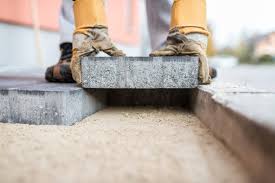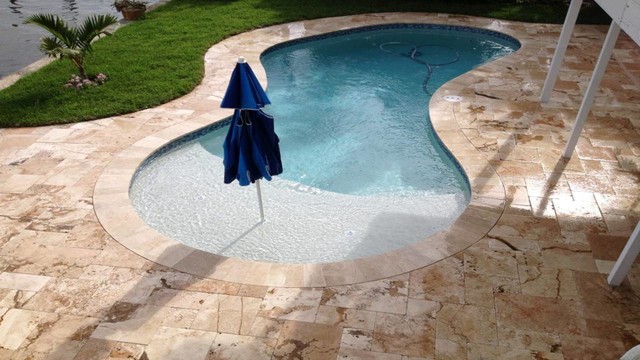
People often go back and forth between travertine and concrete pavers when deciding on the design of an outdoor area. However, travertine pavers often cut in square or rectangles, are a more artistically enticing alternative because of their distinct qualities and look. Concrete pavers can’t be compared to travertine because they are made and not entirely natural, like travertine. You have a variety of options for buying pavers for your patio, one of which is which type to choose. The benefits and cons of concrete and travertine pavers for your patio are examined in further detail.

It’s also important to consider the temperature of the ground while picking between concrete and travertine. Due to its porous nature, travertine is often 30 to 40 percent cooler than concrete. While concrete pavers come in only a single hue, ivory grey, travertine comes in a wide range of colors, including stunning reds and golds. Travertine may be used in various ways, such as pavers, tiles, mosaics, moldings, driveways, and decks depending on the scope of your project. Here in this article, we will guide our viewers about Travertine Pavers Vs. Concrete Pavers.
Appearance
Choosing a paver is mostly a matter of personal preference. Because travertine pavers are manufactured entirely of natural stone, they have a distinct and earthy appearance. While concrete pavers may be created to look like travertine, they will never get the same natural features. On the other hand, Concrete pavers provide you with greater discretion over the color of the pavers you pick.
Shape
It’s not unusual to find oddly shaped pavers in the form of squares, triangles, rectangles with wavy edges, and more. Concrete pavers, which are artificial, may be molded into certain forms since they are easier to shape than natural stone. Travertine pavers, which originate from the soil, are often available in square or rectangular forms.
Price
Travertine pavers are made from natural stones, which means they must be mined from the places where they are located. As a result, they’re more challenging to come by and much more expensive to set up. Because concrete pavers can be created whenever and wherever they are needed, they are more cost-effective. Travertine paver repair costs tend to be greater than concrete paver repair costs when it comes to maintenance.
Durability
Pavers that can withstand heavy use are what you want when it comes to your driveway. Travertine pavers come in handy here. Because they are made of calcified materials, they are highly durable and have been used for thousands of years in buildings.
Resale Worth
Because travertine pavers are more desirable than concrete pavers when it comes time to sell your home, you’ll likely get a higher price for your property if you choose to use them. Travertine pavers will increase your home’s resale value since natural stone is rarer and much more expensive than concrete.
Concrete vs. Travertine – Pros

If you choose travertine or concrete pavers, the final decision comes down to aesthetic preference and budget. Your desired look and feel. However, each has its pros and downsides.
Advantages Of Travertine Pavers
- Ecologically sound
- Slippery proof
- Extremely long-lasting.
- Unique and adds value to a property by giving it a high-end appearance.
- Even though the hues are more subdued, there is a wide range of shades and colors available.
- Has a wide range of potential uses.
- Resilient in the face of muck and dirt
- Low maintenance/upkeep
Advantages Of Concrete Pavers
- Increases the value of your house right away.
- Affordable
- Colors to suit any mood or occasion
- It has a wide range of textures and forms.
- It can be utilized in a variety of ways.
- You can do many smaller projects yourself, such as building a sidewalk, a pathway, or a tiny patio.
Travertine Pavers Vs Concrete Pavers

Travertine and concrete pavers are frequently compared when deciding how to arrange the design of outdoor spaces. These pavers are often cut into square or triangular shapes, but their qualities and unusual look make them an attractive option. Because concrete pavers are artificial, they cannot be compared to travertine pavers because they are not entirely natural like travertine. To get the same texture as travertine, 2 3/8″ thick concrete pavers take extra polishing.
When determining whether to purchase concrete or travertine pavers, the surface temperature is an important consideration. Due to its porous nature, travertine is often 20% to 30% colder than concrete, on average. Summer heat won’t be an issue because it’s in keeping with safety regulations. It is also possible to coat the travertine pavers in pools to avoid mold and damage.
Concrete pavers are vulnerable to freezing and cracking during harsh weather conditions. It’s also possible that the color will fade over time due to rain, sleet, and snow. The colors of travertine come from the Earth. Thus, no stain will be needed on the surface. Travertine pavers also don’t take as long to install as concrete pavers, and they’re more durable.
Conclusion
We hope you liked our article and found it useful. If you have any questions concerning Travertine Pavers Vs. Concrete Pavers, please don’t hesitate to get in touch with us. We’d be happy to assist you in any way we can.
- By: nova admin
- Category: Uncategorized
- 0 comment
